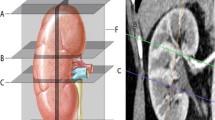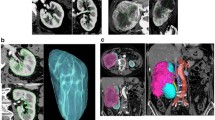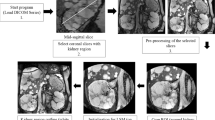Abstract
Small renal masses are commonly diagnosed with modern medical imaging. Renal tumour volume has been explored as a prognostic tool to help decide when intervention is needed and appears to provide additional prognostic information for smaller tumours compared with tumour diameter. However, the current method of calculating tumour volume in clinical practice uses the ellipsoid equation (π/6 × length × width × height) which is an oversimplified approach. Some research groups trace the contour of the tumour in every image slice which is impractical for clinical use. In this study, we demonstrate a method of using 3D segmentation software and the 3D interpolation method to rapidly calculate renal tumour volume in under a minute. Using this method in 27 patients that underwent radical or partial nephrectomy, we found a 10.07% mean absolute difference compared with the traditional ellipsoid method. Our segmentation volume was closer to the calculated histopathological tumour volume than the traditional method (p = 0.03) with higher Lin’s concordance correlation coefficient (0.79 vs 0.72). 3D segmentation has many uses related to 3D printing and modelling and is becoming increasingly common. Calculation of tumour volume is one additional benefit it provides. Further studies on the association between segmented tumour volume and prognosis are needed.



Similar content being viewed by others
References
O'Connor SD, Pickhardt PJ, Kim DH, Oliva MR, Silverman SG. Incidental finding of renal masses at unenhanced CT: Prevalence and analysis of features for guiding management. AJR American journal of roentgenology. 197(1):139-45, 2011
Ali S, Ahn T, Papa N, Perera M, Teloken P, Coughlin G, et al; Changing trends in surgical management of renal tumours from 2000 to 2016: a nationwide study of Medicare claims data. ANZ J Surg, 2019
Wah TM, Irving HC, Gregory W, Cartledge J, Joyce AD, Selby PJ. Radiofrequency ablation (RFA) of renal cell carcinoma (RCC): Experience in 200 tumours. BJU Int. 113(3):416-28, 2014
Warren AY, Harrison D. WHO/ISUP classification, grading and pathological staging of renal cell carcinoma: Standards and controversies. World J Urol. 36(12):1913-26, 2018
Jorns J, Thiel DD, Lohse CM, Williams A, Arnold ML, Cheville JC, et al; Three-dimensional tumour volume and cancer-specific survival for patients undergoing nephrectomy to treat pT1 clear-cell renal cell carcinoma. BJU Int. 110(7):956-60, 2012
Choi SM, Choi DK, Kim TH, Jeong BC, Seo SI, Jeon SS, et al; A comparison of radiologic tumor volume and pathologic tumor volume in renal cell carcinoma (RCC). PloS one. 10(3):e0122019-e, 2015
Chen MY, Skewes J, Desselle M, Wong C, Woodruff MA, Dasgupta P, et al; Current applications of three-dimensional printing in urology. BJU Int. 125(1):17-27, 2020
Chen MY, Skewes J, Woodruff MA, Rukin NJ. Using bespoke 3D-printed models to improve patient understanding of an encrusted ureteric stent. J Clin Urol. 2051415819876514, 2019
Checcucci E, de Cillis S, Porpiglia F, (2020) 3D-printed models and virtual reality as new tools for image-guided robot-assisted nephronsparing surgery. Curr Opin Urol 30 (1):55-64
Hyde ER, Berger LU, Ramachandran N, Hughes-Hallett A, Pavithran NP, Tran MGB, et al; Interactive virtual 3D models of renal cancer patient anatomies alter partial nephrectomy surgical planning decisions and increase surgeon confidence compared to volume-rendered images. Int J Comput Assist Radiol Surg. 14(4):723-32, 2019
Kamai T, Furuya N, Kambara T, Abe H, Honda M, Shioyama Y, et al; Single minimum incision endoscopic radical nephrectomy for renal tumors with preoperative virtual navigation using 3D-CT volume-rendering. BMC Urol. 10:7, 2019
Porpiglia F, Amparore D, Checcucci E, Manfredi M, Stura I, Migliaretti G, et al; Three-dimensional virtual imaging of renal tumours: a new tool to improve the accuracy of nephrometry scores. BJU Int. 124(6):945-54, 2019
Shirk JD, Thiel DD, Wallen EM, Linehan JM, White WM, Badani KK, et al; Effect of 3-dimensional virtual reality models for surgical planning of robotic-assisted partial nephrectomy on surgical outcomes: a randomized clinical trial. JAMA Netw Open. 2(9):e1911598-e, 2019
Thiel DD, Jorns J, Lohse CM, Cheville JC, Thompson RH, Parker AS. Maximum tumor diameter is not an accurate predictor of renal cell carcinoma tumor volume. Scand J Urol. 47(6):472-5, 2013
Smaldone MC, Kutikov A, Egleston BL, Canter DJ, Viterbo R, Chen DYT, et al; Small renal masses progressing to metastases under active surveillance: a systematic review and pooled analysis. Cancer. 118(4):997-1006, 2012
Secil M, Cullu N, Aslan G, Mungan U, Uysal F, Tuna B, et al; The effect of tumor volume on survival in patients with renal cell carcinoma. Diagn Interv Radiol (Ankara, Turkey). 18(5):480-7, 2012
Breau RH, Clark E, Bruner B, Cervini P, Atwell T, Knoll G, et al; A simple method to estimate renal volume from computed tomography. Can Urol Assoc J. 7(5-6):189-92, 2013
Zhang J, Kang SK, Wang L, Touijer A, Hricak H; Distribution of Renal Tumor Growth Rates Determined by Using Serial Volumetric CT Measurements. Radiology. 250(1):137-44, 2009
Herr HW, Lee CT, Sharma S, Hilton S. Radiographic versus pathologic size of renal tumors: Implications for partial nephrectomy. Urology. 58(2):157-60, 2001
Kurta JM, Thompson RH, Kundu S, Kaag M, Manion MT, Herr HW, et al; Contemporary imaging of patients with a renal mass: does size on computed tomography equal pathological size? BJU Int. 103(1):24-7, 2009
Zhang N, Wu Y, Wang J, Xu J, Na R, Wang X; The effect of discrepancy between radiologic size and pathologic tumor size in renal cell cancer. SpringerPlus. 5(1):899, 2016
Khan I, Beksac AT, Paulucci DJ, Abaza R, Eun DD, Bhandari A, et al; Differences in Renal Tumor Size Measurements for Computed Tomography Versus Magnetic Resonance Imaging: Implications for Patients on Active Surveillance. J Laparoendosc Adv Surg Tech. 27(12):1275-8, 2017
Guo Z, Guo N, Gong K, Zhong S, Li Q; Gross tumor volume segmentation for head and neck cancer radiotherapy using deep dense multi-modality network. Phys Med Biol. 64(20):205015, 2019
Yousefi S, Sokooti H, Elmahdy MS, Peters FP, Shalmani MTM, Zinkstok RT, et al; editors. Esophageal Gross Tumor Volume Segmentation Using a 3D Convolutional Neural Network. Medical Image Computing and Computer Assisted Intervention – MICCAI. 2018 2018//; Cham: Springer International Publishing, 2018
Author information
Authors and Affiliations
Corresponding author
Ethics declarations
Conflict of Interest
The authors declare that they have no conflict of interest.
Ethical Approval and Informed Consent
This research study was conducted retrospectively from data obtained for clinical purposes. We consulted extensively with the human research ethics committee of Royal Brisbane and Women’s Hospital who determined that our study did not need ethical approval. An official waiver of ethical approval was granted from the Royal Brisbane and Women’s Hospital human research ethics committee (HREC) study reference LNR/2019/QRBW/51,927. Written consent was not required for this retrospective study with no identifying information.
Additional information
Publisher’s Note
Springer Nature remains neutral with regard to jurisdictional claims in published maps and institutional affiliations.
Supplementary Information
Below is the link to the electronic supplementary material.
Supplementary file1 (MP4 35904 KB)
Rights and permissions
About this article
Cite this article
Chen, M.Y., Woodruff, M.A., Kua, B. et al. Rapid Segmentation of Renal Tumours to Calculate Volume Using 3D Interpolation. J Digit Imaging 34, 351–356 (2021). https://doi.org/10.1007/s10278-020-00416-z
Received:
Revised:
Accepted:
Published:
Issue Date:
DOI: https://doi.org/10.1007/s10278-020-00416-z




